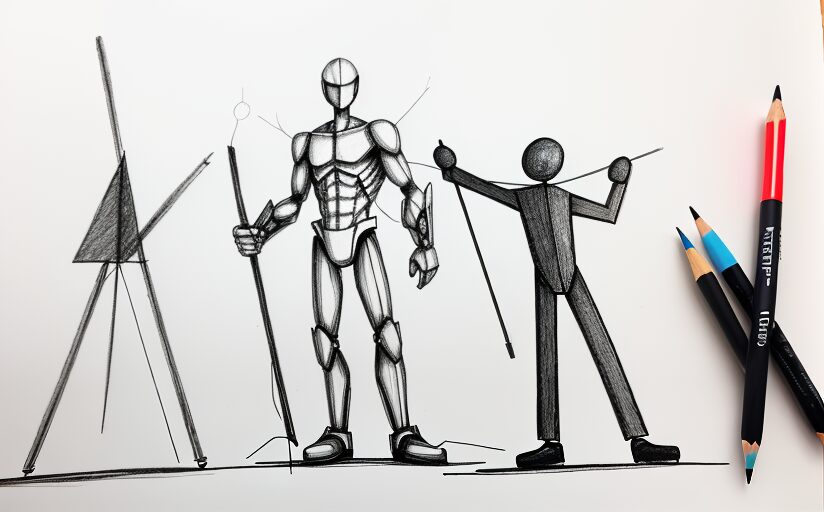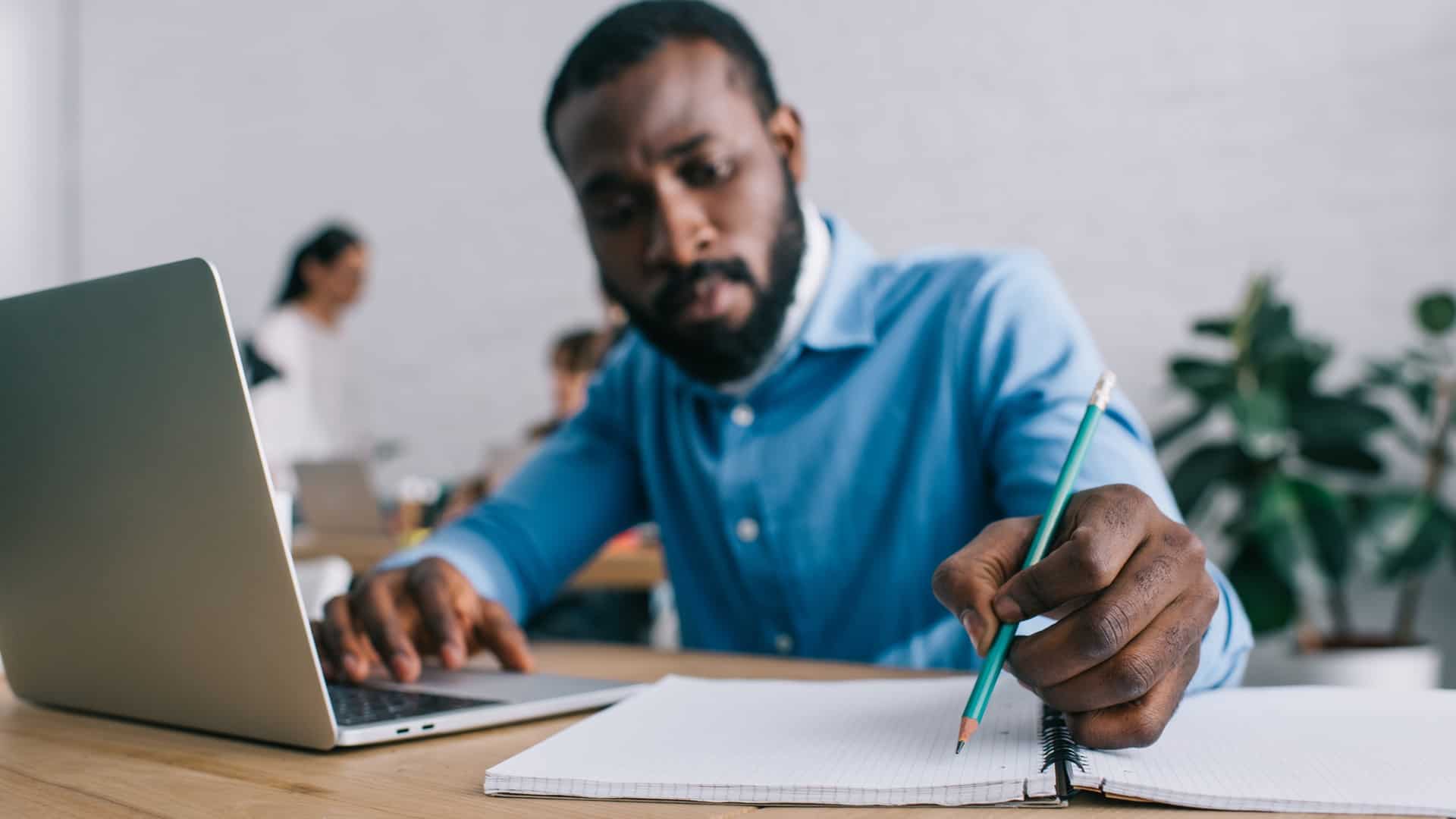Often, I find myself addressing my computer directly, begging it to cooperate with me. “My computer hates me,” is a common phrase I mention to people nearby. I also tend to complain about the ton of socks that need folding and the millions of things I have to do. Basically, I complain a lot, using figure of speech devices like apostrophe, personification and hyperbole.
Describing events in a literal way can be dry and uninteresting. Using figures of speech communicates deeper meaning to deliver more expressive imagery to the listener or reader. In this way, writers and speakers can suggest visuals, create rhetorical effects or produce vivid ideas.

What Is a Figure of Speech?
A figure of speech involves using language in a unique way to paint a distinct picture for the reader. This literary device can be in the form of a phrase or a single word. The intended meaning differs from its ordinary meaning to create an enhanced experience.
Figure of Speech Definition
figure of speech (noun): a word or phrase that intentionally deviates from its literal meaning to produce a rhetorical effect, emphasize or embellish language or create a striking impression.
Why Do Writers Use Figures of Speech?
A skilled writer will use a figure of speech to develop a more memorable description, create an unforgettable impression or convey a specific atmosphere or feeling. Figures of speech communicate information in a more lively and colorful way. These figurative language tools effectively bring words to life, taking readers on a journey through the writer’s intent.
A figure of speech can:
- Add richness to descriptions or events
- Enhance understanding through the use of comparisons
- Develop striking imagery
- Communicate abstract or complex ideas
- Elicit emotion
- Connect ideas that do not have an apparent relationship
- Create memorable sections of prose
- Make the content more relatable and enjoyable
Figure of Speech Examples
Conversational
People often use figures of speech in everyday conversation.
Hyperbole: Exaggerating to highlight a feature or quality
- My backpack weighs a ton.
- I’ll die if I can’t go to the concert.
- That guy is older than dirt.
Oxymoron: Connecting two opposing ideas
- small crowd
- controlled chaos
- original copy
- deafening silence
- clearly confused
Pun: Using words that have similar sounds or applications to create a double meaning
- This vacuum sucks.
- Make like a tree and leave.
- Some bunny loves you.
- Crabs don’t share because they are shellfish.
Understatement: Expressing less emotion than expected to create an effect or show irony
- A person who gets 100% on an exam saying, “I think I did OK.”
- Someone who crashes a car stating, “I put a few scratches on it.”
- Describing below zero weather as “a little chilly.”
Verbal paradox: Using contradictory statements to reveal a truth
- All I know is I know nothing.
- Less is more.
- You make money by spending it.
- The only constant is change.
Euphemism: Replacing harsh phrases with more pleasant words
- Our organization is going to have to let you go.
- My grandpa is over the hill.
- I need to powder my nose.
Writing
Writers employ figures of speech in their work for many reasons.
Simile: Connecting two things with comparison words
- busy as a bee
- cute as a kitten
- run like the wind
- grows like a weed
Metaphor: Comparing things without comparison words
- drowning in a sea of paperwork
- rollercoaster of emotions
- time is a thief
Personification: Attributing human characteristics to an object
- The sunlight danced across the lake.
- That piece of pizza is calling my name.
- The flowers nodded in the breeze.

Literature
Some figure of speech examples found in works of literature include the following:
Personification
William Wordsworth, “I Wandered Lonely as a Cloud”
“A host, of golden daffodils; / Beside the lake, beneath the trees, / Fluttering and dancing in the breeze.”
Alliteration
Toni Morrison, “Sula“
“It was a fine cry – loud and long – but it had no bottom, and it had no top, just circles and circles of sorrow.”
Paradox
William Shakespeare, “Julius Caesar“
“Cowards die many times before their deaths; The valiant never taste of death but once.”
Understatement
J.D. Salinger, “The Catcher in the Rye“
“It isn’t very serious. I have this tiny little tumor on the brain.”
Simile
F. Scott Fitzgerald, “The Great Gatsby“
“In his blue gardens, men and girls came and went like moths …”
Common Figures of Speech
| Figure of Speech | Definition | Example |
| alliteration | The repetition of the first consonant sounds in a group of words | potential power play |
| anaphora | The repetition of words at the beginnings of a sequence of clauses | “So let freedom ring from the prodigious hilltops of New Hampshire. Let freedom ring from the mighty mountains of New York. Let freedom ring from …” (Martin Luther King, Jr., “I Have a Dream” speech) |
| antithesis | A rhetorical device that pairs contrasting ideas by using parallel structure | No guts, no glory |
| apostrophe | Directly addressing someone or something that is not present | “O Romeo, Romeo, wherefore art thou Romeo?” (Shakespeare, “Romeo and Juliet“) |
| assonance | The repetition of vowel sounds within lines of text | Go slow over the road |
| chiasmus | A rhetorical figure in which words or concepts repeat in reverse order | “Pleasure’s a sin, and sometimes sin’s a pleasure.” (Lord Byron, “Don Juan”) |
| euphemism | Figurative language used to replace an unpleasant expression with an agreeable one | passed away |
| hyperbole | Intentional exaggeration | Her smile was a mile wide. |
| irony | Conveying meaning by using language that typically signifies the opposite | Saying, “What a lovely day!” during a hurricane. |
| litotes | A form of verbal irony using understatement | He’s no spring chicken. |
| metaphor | A comparison by using one word in place of another | This room is a pigsty. |
| metonymy | Substitution for a name or attribute of a thing or concept | Referring to the American administration as “The White House” |
| onomatopoeia | Words that sound like their meaning | hiss, sizzle, crack |
| oxymoron | A self-contradicting statement | definite possibility |
| paradox | A seemingly contradictory statement that also conveys truth | This is the beginning of the end. |
| personification | Giving human characteristics to something nonhuman | The wind howled. |
| pun | A play on words using words that sound similar or convey two possible meanings | I’m a baker because I knead the dough. |
| simile | A direct comparison of two things using comparison words, such as, “like” or “as” | You were as brave as a lion. |
| synecdoche | A figure of speech in which a part represents the whole or vice versa | Referring to a vehicle as “wheels.” |
| understatement | A device in which something is made to seem less important than it is | Saying you “lost a couple of dollars” after losing thousands in a poker game. |

What Are the Types of Figures of Speech?
There are numerous kinds of figurative language that are figures of speech. Scholars divide the many forms into two primary categories: tropes and schemes.
Tropes
A literary trope utilizes figurative language to create an artistic image. It originates from the Greek word “trepein,” which means “to turn, to alter, to change.” Tropes change the usual meaning of words to convey a vivid picture or description. Below is the full list of literary tropes.
| accismus | allegory | allusion | ambiguity | anacoenosis |
| analogy | anapodoton | antanaclasis | anthimeria | anthropomorphism |
| antimetabole | antiphrasis | antistasis | antonomasia | aphorism |
| apologia | aporia | apophasis | appositive | apostrophe |
| archaism | auxesis | bathos | burlesque metaphor | catachresis |
| cataphora | categoria | cliche | circumlocution | congeries |
| correctio | dehortatio | denominatio | diatyposis | double negative |
| dirimens copulatio | distinctio | dyphemism | dubitatio | ekphrasis |
| epanorthosis | encomium | enumeratio | epicrisis | epiplexis |
| epitrope | erotema | erotesis | euphemism | grandiloquence |
| exclamation | humor | hyperbation | hyperbole | hypocatastasis |
| hypophora | Hysteron proteron | illeism | innuendo | inversion |
| irony | litotes | malapropism | meiosis | memento verbum |
| merism | metalepsis | metaphor | metonyymy | negative question |
| neologism | nosism | non sequitur | occupatio | onomatopoeia |
| oxymoron | par’hyponoian | parable | paradiastole | paradox |
| paraprosdokian | paralipsis | parody | paronomasia | pathetic fallacy |
| periphrasis | personification | pleonasm | pareteritio | procatalepsis |
| proslepsis | prothesis | proverb | pun | redundancy |
| rhetorical question | satire | sensory detail | sesquipedalianism | simile |
| snowclone | style | superlative | syllepsis | syncatabasis |
| synchoresis | synecdoche | synesthesia | tautology | transferred epithet |
| truism | tricolon diminuens | tricolon crescens | verbal paradox | verba ex ore |
| verbum volitans | zeugma | zoomorphism |
Schemes
Schemes change word order, patterns, syntax, sounds or letters instead of altering the meanings of words or phrases. Below is the full list of literary schemes.
| accumulation | adnomination | alliteration | adynaton | anacoluthon |
| anadiplosis | anaphora | anastrophe | anti-climax | anthimeria |
| antimetabole | antirrhesis | antistrophe | antithesis | aphorismus |
| aposiopesis | apposition | assonance | asteismus | asterismos |
| asyndeton | cacophony | cataphora | classification | chiasmus |
| climax | commoratio | conduplicatio | conversion | consonance |
| correlative verse | diacope | dubitatio | dystmesis | ellipsis |
| elision | enallage | enjambment | epanalepsis | epanodos |
| epistrophe | epizeuxis | euphony | half rhyme | hendiadys |
| hendiatris | homeoptoton | homeoteleuton | homographs | homonyms |
| homophones | hypallage | hyperbaton | hyperbole | hypozeuxis |
| hysteron proteron | isocolon | internal rhyme | kenning | litotes |
| merism | mimesis | onomatopoeia | paradiastole | parallelism |
| paraprosdokian | paremvolia | parenthesis | paroemion | parrhesia |
| pleonasm | polyptoton | polysyndeton | pun | rhythm |
| sibilance | sine dicendo | solecism | spoonerism | superlative |
| synathroesmus | syncope | symploce | synchysis | synesis |
| synecdoche | synonymia | tautology | tmesis | zeugma |
Use Figure of Speech To Create Dynamic Prose
With so many figure of speech examples, you are sure to find a way to craft engaging works that leap off the page and hook the reader with the penetrating power of carefully chosen prose.
Leave a comment and tell us which figure of speech techniques you use in your writing or everyday life. We are all ears!


Leave a Reply